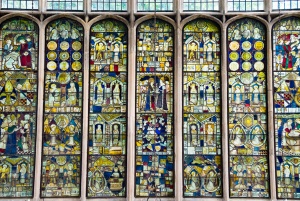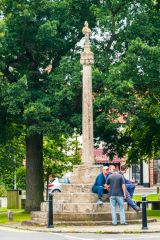
Tattershall Castle
First, there are the imposing remains of Tattershall Castle, built in 1440 for Ralph Cromwell, Lord High Treasurer of England under Henry VI. Cromwell was one of the wealthiest and most important men in the country, and he wanted a house that suited his status. So he chose as the building material for his new castle ... red brick.
Though it is now ubiquitous and deemed a fairly common building material, in the 15th century brick was the height of fashion, and much more costly than stone or timber. So Cromwell's new castle was built in brick, as a statement of his wealth.
Cromwell was also responsible for the row of pretty almshouses beside the path to the castle.
Holy Trinity Church
Just beside the castle and almshouses is the superb Perpendicular Gothic church dedicated to the Holy Trinity. This is one of the finest examples of Perpendicular architecture in England, and well worth a visit. Cromwell granted money for the church but died before it could be built. It retains magnificent medieval stained glass, a rood loft, and a collection of memorial brasses.
Near the font is a plaque commemorating Tom Thumb, a resident of Tattershall. Thumb, who died in 1620 at the ripe old age of 101, was said to stand just 18.5 inches high. His tiny house is set on the roof of another normal-sized house on the market place.
In the market square, a 15th-century cross still stands. This 'Buttercross' is set on an octagonal base and is a scheduled ancient monument. It marks the site of a weekly market, granted by a charter of King John in 1201. In exchange for the market charter, King John demanded an annual rent - not of money, but of a trained goshawk for hunting.
Tattershall College
Down a nearby alley stand the remains of Tattershall College, built by, yes, Ralph Cromwell, to train choristers for Holy Trinity Church. Built of brick and stone in Perpendicular Gothic style, the college later served as a brewery. It is roofless and in the care of English Heritage.
There are 2 pubs; the Fortescue Arms and the Black Horse. The Fortescue Arms is the most historically interesting; it dates to the 15th century and is listed Grade II for historic value.









 We've 'tagged' this attraction information to help you find related historic attractions and learn more about major time periods mentioned.
We've 'tagged' this attraction information to help you find related historic attractions and learn more about major time periods mentioned.




